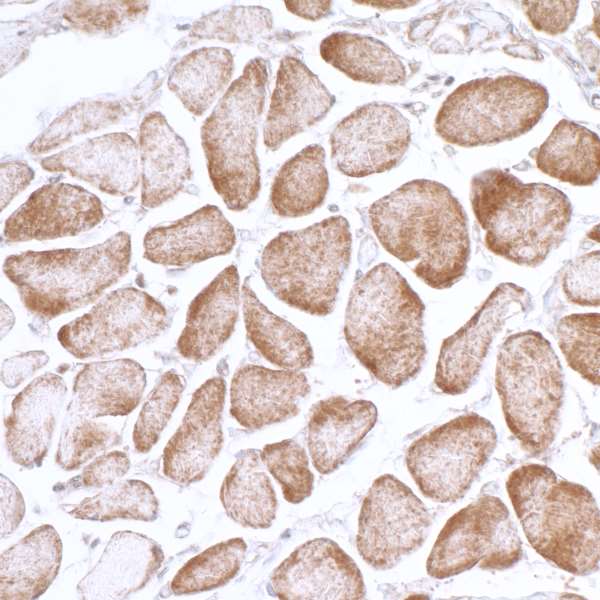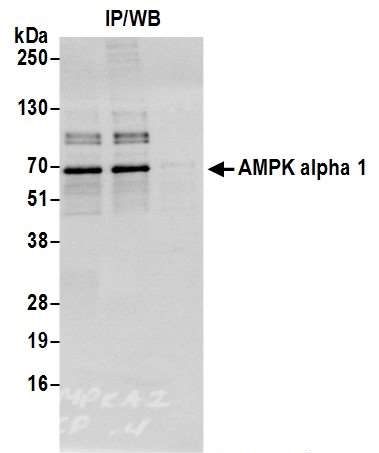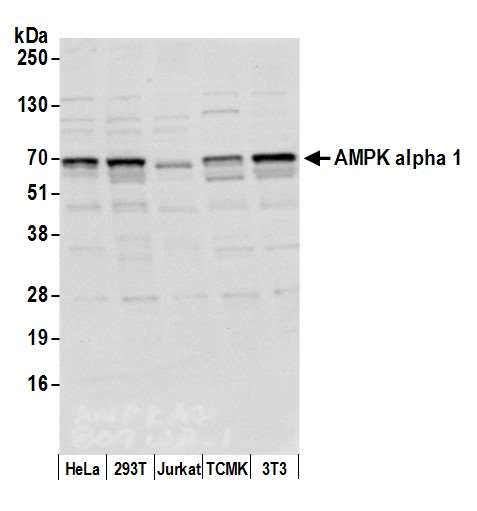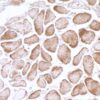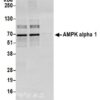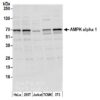Anti-AMPKα 1 Antibody (13008)
$518.00
SKU: 13008
Categories: Antibody Products, Enzymes and Enzyme Inhibitor Antibodies, Products
Overview
Product Name Anti-AMPKα 1 Antibody (13008)
Description Anti-AMPKα 1 Rabbit Polyclonal Antibody
Target AMPKα 1
Species Reactivity Human, Rat, Bovine
Applications WB,IP,IHC
Host Rabbit
Clonality Polyclonal
Isotype Whole IgG
Immunogen Synthetic peptide representing a portion of the protein encoded within exon 8.
Properties
Form Liquid
Concentration Lot Specific
Formulation Tris-citrate/phosphate buffer, pH 7 to 8 containing 0.09% Sodium Azide
Buffer Formulation Tris
Buffer pH pH 7.8
Buffer Anti-Microbial 0.1% Sodium Azide
Format Purified
Purification Purified by immunoaffinity chromatography
Specificity Information
Specificity This antibody reacts with human, mouse, rat and bovine AMP activated protein kinase, alpha-1 catalytic subunit. Based on 100% sequence identity, this antibody is predicted to react with Chicken, Turkey, Dog, Horse, Rabbit, Guinea pig, Pig, Panda, Orangutan, Rhesus Monkey, Gorilla, Chimpanzee, West Indian ocean coelacanth, Medaka fish, Nile tilapia, Duckbill platypus and Three-spined stickleback. Antibody is affinity purified.
Target Name 5'-AMP-activated protein kinase catalytic subunitα-1
Target ID AMPKα 1
Uniprot ID Q13131
Alternative Names AMPK subunitα-1, EC 2.7.11.1, Acetyl-CoA carboxylase kinase, ACACA kinase, EC 2.7.11.27, Hydroxymethylglutaryl-CoA reductase kinase, HMGCR kinase, EC 2.7.11.31, Tau-protein kinase PRKAA1, EC 2.7.11.26
Gene Name PRKAA1
Accession Number NP_006242
Sequence Location Cytoplasm, Nucleus
Biological Function Catalytic subunit of AMP-activated protein kinase (AMPK), an energy sensor protein kinase that plays a key role in regulating cellular energy metabolism (PubMed:17307971, PubMed:17712357). In response to reduction of intracellular ATP levels, AMPK activates energy-producing pathways and inhibits energy-consuming processes: inhibits protein, carbohydrate and lipid biosynthesis, as well as cell growth and proliferation (PubMed:17307971, PubMed:17712357). AMPK acts via direct phosphorylation of metabolic enzymes, and by longer-term effects via phosphorylation of transcription regulators (PubMed:17307971, PubMed:17712357). Regulates lipid synthesis by phosphorylating and inactivating lipid metabolic enzymes such as ACACA, ACACB, GYS1, HMGCR and LIPE; regulates fatty acid and cholesterol synthesis by phosphorylating acetyl-CoA carboxylase (ACACA and ACACB) and hormone-sensitive lipase (LIPE) enzymes, respectively (By similarity). Promotes lipolysis of lipid droplets by mediating phosphorylation of isoform 1 of CHKA (CHKalpha2) (PubMed:34077757). Regulates insulin-signaling and glycolysis by phosphorylating IRS1, PFKFB2 and PFKFB3 (By similarity). AMPK stimulates glucose uptake in muscle by increasing the translocation of the glucose transporter SLC2A4/GLUT4 to the plasma membrane, possibly by mediating phosphorylation of TBC1D4/AS160 (By similarity). Regulates transcription and chromatin structure by phosphorylating transcription regulators involved in energy metabolism such as CRTC2/TORC2, FOXO3, histone H2B, HDAC5, MEF2C, MLXIPL/ChREBP, EP300, HNF4A, p53/TP53, SREBF1, SREBF2 and PPARGC1A (PubMed:11554766, PubMed:11518699, PubMed:15866171, PubMed:17711846, PubMed:18184930). Acts as a key regulator of glucose homeostasis in liver by phosphorylating CRTC2/TORC2, leading to CRTC2/TORC2 sequestration in the cytoplasm (By similarity). In response to stress, phosphorylates 'Ser-36' of histone H2B (H2BS36ph), leading to promote transcription (By similarity). Acts as a key regulator of cell growth and proliferation by phosphorylating TSC2, RPTOR and ATG1/ULK1: in response to nutrient limitation, negatively regulates the mTORC1 complex by phosphorylating RPTOR component of the mTORC1 complex and by phosphorylating and activating TSC2 (PubMed:14651849, PubMed:18439900, PubMed:20160076, PubMed:21205641). In response to nutrient limitation, promotes autophagy by phosphorylating and activating ATG1/ULK1 (PubMed:21205641). In that process also activates WDR45/WIPI4 (PubMed:28561066). Phosphorylates CASP6, thereby preventing its autoprocessing and subsequent activation (PubMed:32029622). In response to nutrient limitation, phosphorylates transcription factor FOXO3 promoting FOXO3 mitochondrial import (By similarity). Also acts as a regulator of cellular polarity by remodeling the actin cytoskeleton; probably by indirectly activating myosin (PubMed:17486097). AMPK also acts as a regulator of circadian rhythm by mediating phosphorylation of CRY1, leading to destabilize it (By similarity). May regulate the Wnt signaling pathway by phosphorylating CTNNB1, leading to stabilize it (By similarity). Also has tau-protein kinase activity: in response to amyloid beta A4 protein (APP) exposure, activated by CAMKK2, leading to phosphorylation of MAPT/TAU; however the relevance of such data remains unclear in vivo (By similarity). Also phosphorylates CFTR, EEF2K, KLC1, NOS3 and SLC12A1 (PubMed:20074060, PubMed:12519745). {UniProtKB:P54645, UniProtKB:Q5EG47, PubMed:11518699, PubMed:11554766, PubMed:12519745, PubMed:14651849, PubMed:15866171, PubMed:17486097, PubMed:17711846, PubMed:18184930, PubMed:18439900, PubMed:20074060, PubMed:20160076, PubMed:21205641, PubMed:28561066, PubMed:32029622, PubMed:34077757, PubMed:17307971, PubMed:17712357}.
Research Areas Enzymes
Background AMP-activated protein kinase (AMPK) is a heterotrimeric protein made up of a catalytic alpha subunit and regulatory beta and gamma subunits. There are two distinct genes for the alpha subunit, alpha1 and alpha2. AMPK alpha 1 is the serine/threonine kinase catalytic subunit of the AMPK. AMPK is responsible for regulating fatty acid and cholesterol synthesis.
Application Images




Description Detection of human AMPK alpha 1 by immunohistochemistry. Sample: FFPE section of human smooth muscle. Antibody: Affinity purified rabbit anti-AMPK alpha 1 (Cat. No. 13008 Lot 3) used at a dilution of 1:1,000 ( 1µg/ml). Detection: DAB

Description Detection of human AMPK alpha 1 by western blot of immunoprecipitates. Samples: Whole cell lysate (1.0 mg per IP reaction; 20% of IP loaded) from HeLa cells prepared using NETN lysis buffer. Antibodies: Affinity purified rabbit anti-AMPK alpha 1 antibody 13008 (lot 13008-3) used for IP at 3 µg per reaction. AMPK alpha 1 was also immunoprecipitated by a previous lot of this antibody (lot 13008-2). For blotting immunoprecipitated AMPK alpha 1, 13008 was used at 0.4 µg/ml. Detection: Chemiluminescence with an exposure time of 3 seconds.

Description Detection of human and mouse AMPK alpha 1 by western blot. Samples: Whole cell lysate (15 µg) from HeLa, HEK293T, Jurkat, mouse TCMK-1, and mouse NIH 3T3 cells prepared using NETN lysis buffer. Antibody: Affinity purified rabbit anti-AMPK alpha 1 antibody 13008 (lot 13008-3) used for WB at 0.1 µg/ml. Detection: Chemiluminescence with an exposure time of 3 seconds.
Handling
Storage This antibody is stable at 2-8°C for 1 year.
Dilution Instructions Dilute in PBS or medium that is identical to that used in the assay system.
Application Instructions Immunoblotting: use at 0.2-2ug/mL
Immunohistochemistry: use at 0.2- 2ug/mL.
Immunohistochemistry: use at 0.2- 2ug/mL.
References & Data Sheet
Data Sheet  Download PDF Data Sheet
Download PDF Data Sheet
 Download PDF Data Sheet
Download PDF Data Sheet

